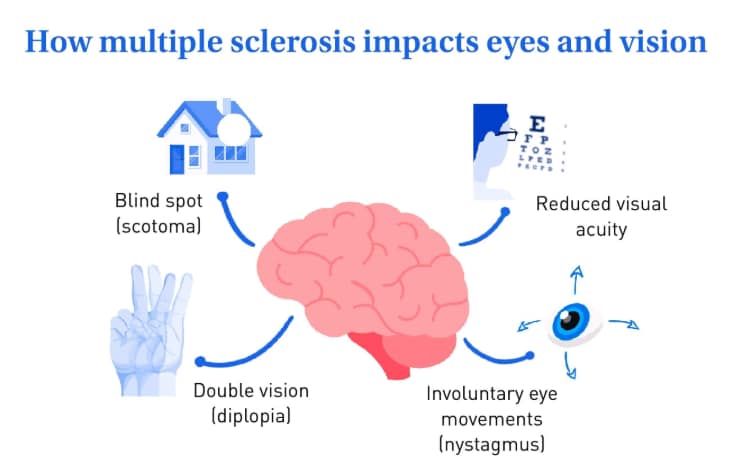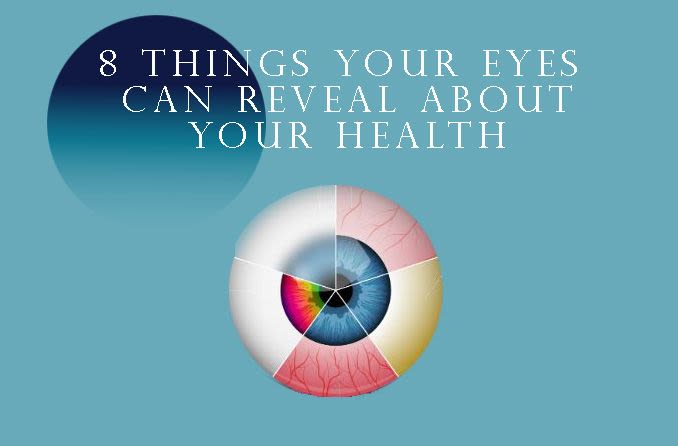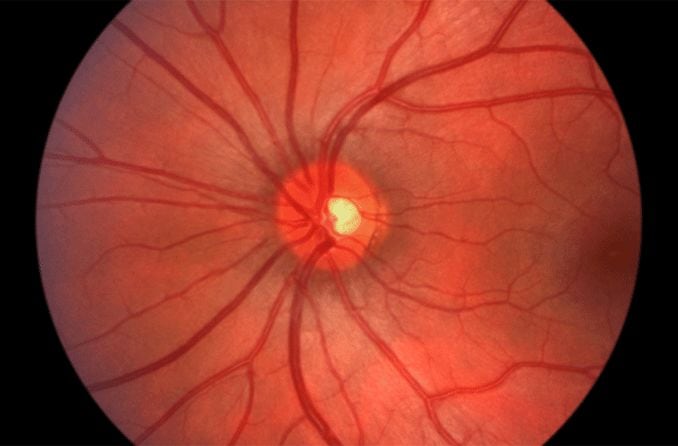MS eye symptoms and vision problems
Multiple sclerosis (MS) is an autoimmune disease that affects the central nervous system (CNS). The CNS includes the brain, spinal cord and optic nerve, which connects the brain to the eyes. A common first symptom of MS is optic neuritis — inflammation of the optic nerve. It causes eye pain, blurry vision and other issues.
Multiple sclerosis affects more than 900,000 Americans and 2.9 million people worldwide. Roughly half of those with MS develop optic neuritis as their first symptom.
Vision problems in MS include:
- Eye pain
- Blurry vision
- Worsening vision loss
- Weakness of eye muscles
- Double vision
- Uncontrolled eye movements
- Grayed-out color vision or red-green color issues
In addition to eye problems, people with MS commonly experience:
- Muscle weakness, spasms or stiffness
- Fatigue
- Numbness and tingling
- Memory issues and cognitive changes
- Difficulty with balance and coordination
These symptoms can make daily activities challenging, such as reading or walking. The earlier MS is diagnosed, treated and managed, the better the patient’s outcome. Detecting vision issues early is essential for managing them.
Common vision problems in multiple sclerosis
Almost three-fourths of individuals with MS experience vision issues within the first 10 years of being diagnosed. These vision issues include:
Optic neuritis
Optic neuritis is an inflammation of the optic nerve, which transmits light signals from the eyes to the brain. It's most commonly seen in 20- to 40-year-old white females. Seven out of 10 people with MS will develop this condition at some point.
Optic neuritis occurs when the immune system attacks the protective layer around the nerve, called myelin. This can disrupt the optic nerve's ability to send signals from the eyes to the brain, causing blurry vision and pain.

This condition typically affects one eye at a time, although it can occasionally affect both. The vision symptoms of optic neuritis usually develop over hours or days.
Symptoms of optic neuritis include:
- Pain with eye movement (often the first symptom)
- Blurry or hazy vision
- Temporary blindness or a dark spot in one eye
- Color desaturation or grayed color vision
- A depth perception phenomenon where 2D objects appear to be 3D (Pulfrich phenomenon)
Optic neuritis usually gets better on its own. Symptoms typically get worse over a few days and start to improve within two to four weeks as the swelling goes down. Even though most people regain clear vision, some subtle vision problems can remain. These issues might not be noticeable with regular eye tests. However, they can be detected using special charts that test vision in low-contrast settings.
A comprehensive eye and medical evaluation with imaging studies may be required to diagnose optic neuritis. One such imaging test is optical coherence tomography (OCT). It is a non-invasive tool that can help identify how the retina's layers are affected.
Double vision (diplopia)
Double vision occurs when inflammation affects the brainstem. This interferes with the nerve signals that control eye movement. When eye movements are not in sync, two different images are sent to the brain.
Strategies such as eye patches and prism glasses can help manage the condition.
Double vision can sometimes occur along with nystagmus (jerky eye movements) and depth perception problems.
Nystagmus
Nystagmus refers to uncontrollable rapid eye movements (jerky eyes). These movements can occur horizontally, vertically or in a circular pattern. Nystagmus results from damage or inflammation in the areas of the brain that control eye movement. These include the brainstem and cerebellum. It can also occur from damage to the optic nerve.
People with nystagmus may experience:
- Disorientation or dizziness
- The sensation that the room is moving
- Balance difficulties
- Visual instability
Nystagmus symptoms can be challenging to treat. If needed, doctors might prescribe glasses, contacts or medication to help control the condition. Strategies such as tilting the head at a certain angle can also help some people feel less disoriented.
Less common MS eye symptoms
During an optic neuritis flare-up, additional eye symptoms can occur. These may include:
Vision loss
Partial or temporary vision loss associated with optic neuritis can disrupt daily life, affecting a person’s ability to read, cook and work. Vision loss is the result of inflammation of the optic nerve. It typically affects one eye and develops over a short period. Permanent blindness because of MS is rare. Most people recover fully or partially within a few weeks.
Color vision changes
Color perception issues, such as seeing "washed-out" colors, are common in MS patients with optic neuritis. This phenomenon occurs because of damage to the nerve fibers that transmit color signals to the brain. As a result, colors may appear less vibrant, particularly reds. Many people regain normal color vision as inflammation goes down. Some people may continue to experience subtle color vision issues.
Eye pain
Pain with eye movement is often an early sign of optic neuritis. It's caused by inflammation of the optic nerve, which becomes sensitive to movement. This discomfort is usually mild to moderate and worsens when the eyes move. The pain typically goes away within a few days, often before vision improves.
Causes of vision problems in MS
MS is an autoimmune disease that results in inflammation in the myelin — the protective layer that surrounds nerve fibers. The inflammation damages the myelin surrounding the nerves. As a result, signals traveling in the injured part of the optic nerve are interrupted or delayed. This can affect the optic nerve and the areas in the brain that control eye movement. This can lead to blurry vision, double vision, nystagmus and other vision issues.
The inflammation that causes vision problems can be triggered by various factors, including:
- Stress
- Infection
- Heat
- Fatigue
This is why many people experience worsening symptoms if they have a fever or become overheated. This relationship between higher body temperature and worsened vision symptoms is known as Uhthoff's phenomenon.
A recent report found that changes in the retina, like thinning, can cause vision issues for people with multiple sclerosis. A test called microperimetry can help doctors find these changes earlier. This test measures how different parts of the eye react to light.
The important finding was that people with MS have more difficulty detecting light in areas where the retina is thinning. These developments can help researchers better understand the causes of vision problems in MS..
Managing MS eye symptoms
Treatment for MS-related vision problems is managed by an ophthalmologist and a neurologist. It is based on the specific symptoms, severity and unique needs of each patient. Treatment aims to reduce inflammation, manage symptoms and prevent further damage.
Optic neuritis symptoms typically peak within a few days. They begin to improve within two to four weeks as inflammation decreases. Complete recovery may take several months. Although not common, some people may experience permanent vision changes.
Sometimes, a doctor may need to prescribe medications during an optic neuritis flare-up. These include high-dose prednisone pills or IV steroids. These drugs decrease the inflammation of the optic nerve and improve vision more quickly.
If nystagmus continues for an extended period, medication may be needed to treat it as well.
Strategies for managing MS eye symptoms include:
- Rest periods to manage fatigue-related visual symptoms
- Avoiding heat triggers
- Eye patches or prism glasses for double vision
- Prism glasses for double vision
- Vision therapy exercises
- Medications for nystagmus
- Low vision aids
When to see a doctor for MS vision problems
If you experience the following symptoms, contact your doctor as soon as possible:
- Sudden vision loss in one eye
- New onset of double vision
- Eye pain, especially with movement
- Blurred vision that doesn't resolve quickly
- Changes in color perception
- Any visual changes accompanied by other neurological symptoms
Most people with multiple sclerosis have episodes of inflammation that may come and go over time. This is known as relapsing-remitting MS. However, some people's symptoms may gradually worsen over time without any cooling-off (remission) periods. This is called progressive MS.
Episodes of inflammation are unpredictable. A person could go weeks or even years between episodes.
MS diagnosis typically involves:
- Comprehensive eye examination by a neuro-ophthalmologist
- Neurological evaluation
- Magnetic resonance imaging (MRI) of the brain and orbits (eyes)
- Visual field testing
- Optical coherence tomography (OCT)
The earlier this condition is diagnosed, treated and managed, the better the patient’s outcome.
Living with MS eye symptoms? Get support
Daily activities can be more difficult when multiple sclerosis affects your vision. Trusted health care providers are key to managing eye and vision complications. New treatments are being developed and researched to help treat eyesight issues caused by MS. Plus, you can improve your chances of staying healthy by eating a balanced diet, not smoking and making other good lifestyle choices.
The following organizations can provide additional support:
- National Multiple Sclerosis Society (USA)
- Multiple Sclerosis Association of America (USA)
- Multiple Sclerosis Foundation, known as MS Focus (USA)
- MS International Federation (global)
- Rehabilitation in Multiple Sclerosis (Europe)
- Multiple Sclerosis Trust (UK)
For those diagnosed with MS, regular eye examinations are important. This is true even when no ocular symptoms are present, as subtle changes can sometimes be detected by an eye doctor before they become noticeable.
For example, OCT evaluates the retinal nerve fiber layer and can detect damage even before symptoms appear. Early diagnosis and proper treatment can improve your chances of recovering from vision problems caused by MS.
READ NEXT: Is eye twitching a sign of MS?







